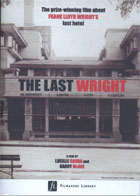
The Last Wright: an Architect, A Hotel, A City, A Century 2009
Distributed by Filmakers Library, 124 East 40th Street, New York, NY 10016; 202-808-4980
Produced by Garry McGee and Lucille Carra
Directed by Lucille Carra
DVD, color, 52 min.
Sr. High - Adult
Architecture, Urban Studies
Date Entered: 02/22/2010
Reviewed by Sandy River, Architecture and Humanities Librarian, Texas Tech UniversityIn January, 2010, construction contracts were signed for the restoration of the world’s last remaining hotel designed by Frank Lloyd Wright. The hotel’s story begins with competition between two Mason City, Iowa banks. In 1908, Wright was commissioned to design a bank building and adjoining hotel on a public park. The project was completed in 1910, but Wright had already eloped to Europe in scandal. The hotel was in the Prairie style and was quite modern, though not luxurious, with two rooms sharing a bath. The bank was sold in the late 1920s, and over time, the hotel struggled as newer lodging was built. Eventually, it was converted to “bottom of the line” apartments and later was abandoned. Bulldozing of the downtown area for 1980s urban renewal stopped a block from the hotel.
Recognizing both the value and tourism potential of the hotel, the Mason City Foundation purchased the building in 2000 with the stipulation that renovations be completed in five years. The mayor had suggested making it a Meredith Wilson museum, honoring the native son who had written The Music Man. In 2002 the city opened Music Man Square, but by 2005, with renovation of the hotel scarcely begun, the city took back the hotel. After an unsuccessful attempt to sell the hotel on eBay, a new entity, Wright on the Park, Inc., took over renovation efforts. The project is expected to be completed in 2011. This film is in three parts. The opening segment is about Frank Lloyd Wright – his ideas about architecture, some of his buildings, and the influence of his Japan visits on his work. The second is about Mason City’s history as an early industrial town, the site of a Dillinger bank robbery, the decline of the city’s manufacturing base, and a reputation as “porn city” in the 1970s. The final segment is titled “Preservation,” but it first shows some of the Wright buildings that have been demolished and then presents the later hotel history I describe above. Obviously, other films provide a more complete picture of Wright’s work. Many viewers may find the section on Mason City of limited interest. And the final section takes us only to the 2007 removal of the ceiling layer that blocked the natural light in the lobby area.
It could be that the film tries to cover too much ground, but for an historical preservation class, it might be instructive to see how a building, even a building designed by a renowned architect, can fall into disrepair and how much effort and money it takes to get a renovation project off the ground. A class studying how towns develop, decline, and try to recover would also benefit from viewing this film.
The film relies on historical footage, commentary by those familiar with Mason City history, and the extensive photo representation of Wright’s buildings. Both the visual and audio presentations are of good quality. This would not be a first pick for either architecture or urban studies, but it is an interesting film for a possibly limited audience.
Awards
- Best Documentary, Iowa Motion Picture Association